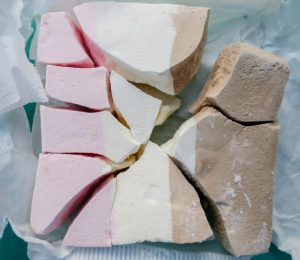Sure, we love great science! We also love great food. It’s true, each Friday we have breakfast as a company and most of our events feature awesome local culinary treats. What’s even more fun is bridging our love of eating (nom nom) with the science we’re passionate about. Today, we got to thinking about a chemical process that affects our food from the way it’s packaged all the way through to when we digest it: hydrolysis.
What is hydrolysis?
If you’ve ever had a basic chemistry class, you’ve heard of hydrolysis. But do you recall what it means at a fundamental level? Simply put, hydrolysis is what happens when a substance reacts with water and is split into smaller compounds. While this seems simple, the world of hydrolysis is very exciting. In fact, we all experience hydrolysis every day–like while you are chowing down!
Hydrolysis happens any time water reacts to break larger compounds–like polymers–into smaller components. This process happens, as you might expect, in your body every day. When we digest food, the compounds that supply us with sustenance and nutrients must first be broken down by our body. Once we eat food, our body begins to process it into glucose, which is what our body can use for fuel. Our body’s digestive system does this very efficiently, by way of hydrolysis!
Hydrolysis can be Problematic
Having compounds undergo hydrolysis is not always ideal. Sometimes you want quite the opposite: absolutely no reaction to water or air. In the case of food preservation, for example, you want to reduce the risk of hydrolysis as much as possible to avoid food spoilage.
Sometimes science is used to thwart hydrolysis. A great example of the negatives of hydrolysis and the steps taken to mitigate the effects is in the act of freeze-drying.

In food preparation, when an item is freeze-dried, the water content is greatly reduced. When this is achieved, it can be kept for long periods of time without the effects of hydrolysis taking place. One fun example of guarding against hydrolysis within a food product is astronaut ice cream.
While astronaut ice cream wasn’t really used much during space flights (a shame, we know), it’s become a staple in gift shops around the country. From the freeze-drying process to the packaging itself, this is a great example of all the ways you can reduce the risk of hydrolysis and keep foods safe for long periods of time!
For some applications, it would be great if hydrolysis just never happened. In others, though, hydrolysis holds the key to great scientific advancement.
Hydrolysis Contributes to Better Patient Outcomes
In one application in particular, hydrolysis allows us to do things that were never possible without the creation of compounds that could be implanted in the body and then slowly “disappear” over an intentional period of time. They’re called bioabsorbable polymers.
In many medical procedures, it’s important to insert a medical device, like a screw or pin, into the body to help things heal. Often, though, the procedure needed to remove that aid is just as invasive. It is also not desirable to have permanent materials left in the body. Both of these scenarios can lead to complications. Here’s where bioabsorbable polymers save the day! They can be implanted into the body, aid in the healing process and then be absorbed into the body by way of hydrolysis. The body then eliminates the degraded bioabsorbable polymer through very normal biological processes (i.e. bathroom breaks!).
These innovations have allowed for better patient outcomes, lower infection risk and fewer doctor’s visits for many patients. When patients require less invasive care, more good can be done with less risk.
Basic or Not, Hydrolysis is Fascinating!
From astronaut food to bioabsorbable implants, the applications of hydrolysis can be both basic and advanced. The bottom line though, it is simply fascinating. For us, experiencing essential chemical processes in complex ways to create a safer, healthier and happier world is nothing short of amazing.
